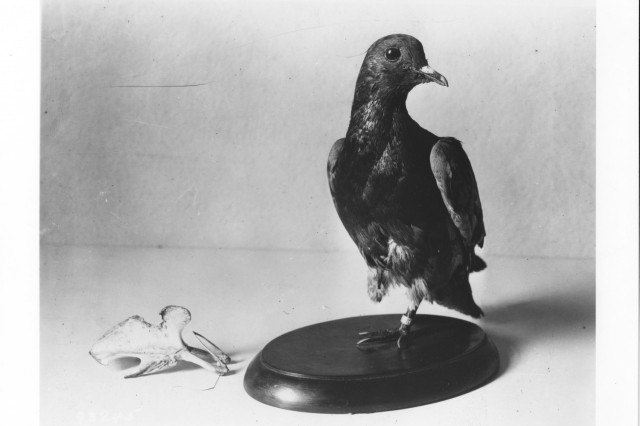ABERDEEN PROVING GROUND, Md. — One of the enduring mysteries of the Signal Corps Pigeon Program, which was headquartered at Fort Monmouth from 1919 until its discontinuation in 1957, was the history of the pigeon named Cher Ami, credited with saving the “Lost Battalion” during the October 1918 battles in the Argonne Forest in France, and later honored with the French Croix de Guerre with palm.
Cher Ami, along with thirty-two other “distinguished” pigeons, ten captured from the Germans, and 132 selected as breeders, arrived at what was then Camp Alfred Vail in 1919, at the new Pigeon Service Headquarters. They were carefully transported across the Atlantic on the transport Ohioan, along with approximately 1600 troops returning from the front, arriving in Hoboken in April 1919.
When Cher Ami passed away due to combat wounds in July 1919, the remains were sent to the Smithsonian’s National Museum of Natural History for preservation. After being mounted by a taxidermist, Cher Ami went on display at the United States National Museum in the Arts and Industries Building in June 1921. During that timeframe, Cher Ami was referred to as both a hen and a cock. The Smithsonian listed Cher Ami as a male, while the Pigeon Service A.E.F. document listing the returning pigeons designed Cher Ami as a female. While not affecting Cher Ami’s attributed service, the question of the pigeon’s sex has continued to be raised over the past century.
In recognition of the centennial of Cher Ami being on display, the Smithsonian Institution recently undertook DNA analysis to make a final determination. The Smithsonian’s blog regarding their work and findings can be found at https://americanhistory.si.edu/blog/cher-ami. The results came in that Cher Ami was a cock bird, answering a century-long question.
In additional to identifying Cher Ami as male, recent scholarship undertaken by Dr. Frank A. Blazich, Jr., , a curator in the Division of Political and Military History at the Smithsonian Institution National Museum of American History, questions the accuracy of the traditional story told about Cher Ami. Taking a more in-depth look at archival resources reveals that the heroic story may have been carefully curated and enhanced to support the development of the Signal Corps Pigeon program, and help show the worth of such a program to the general public. Published in the July 2021 issue of the Journal of Military History* Dr. Blazich’s research, which included sources from the CECOM Historical archive, shows the power of a good story, and discovers that the truth behind the heroics of the world’s most famous pigeon is not always easy to discern.
Whatever the story, truth or fiction, information regarding Cher Ami remains one of the most-requested topics from the CECOM Historical archive. His legacy will remain part of Signal Corps history, and helps tell the story of the evolution of communications across the Army’s history.
*“Notre Cher Ami: The Enduring Myth and Memory of a Humble Pigeon,” by Frank A. Blazich, Jr., Journal of Military History 85:3 (July 2021): 646–77






Social Sharing